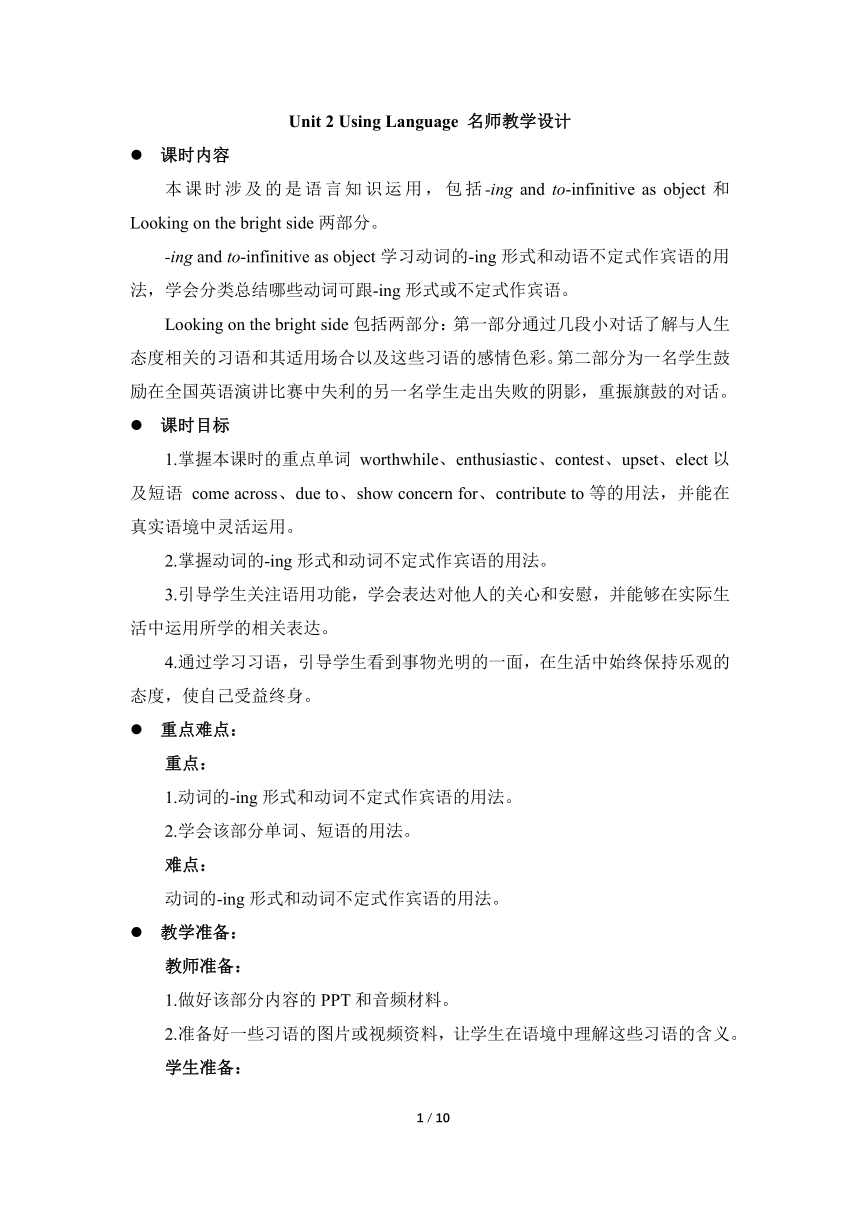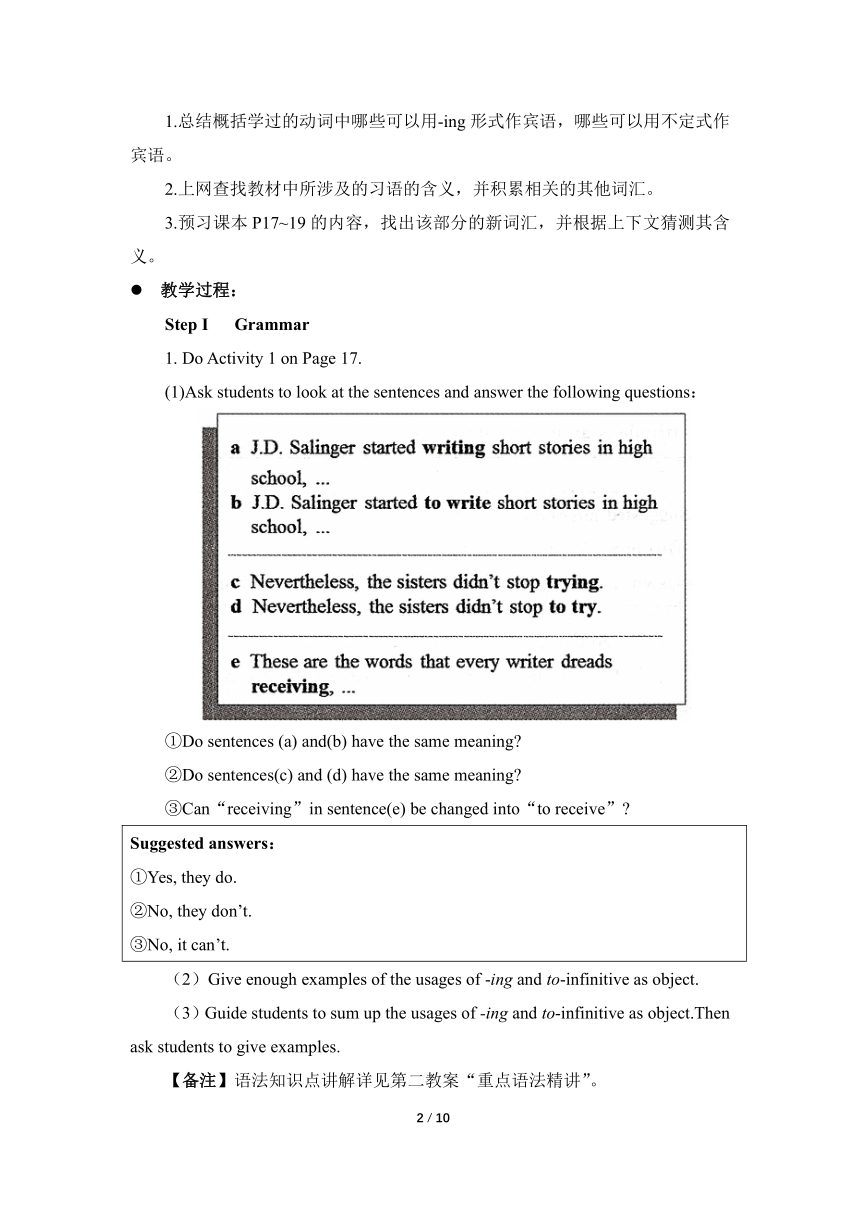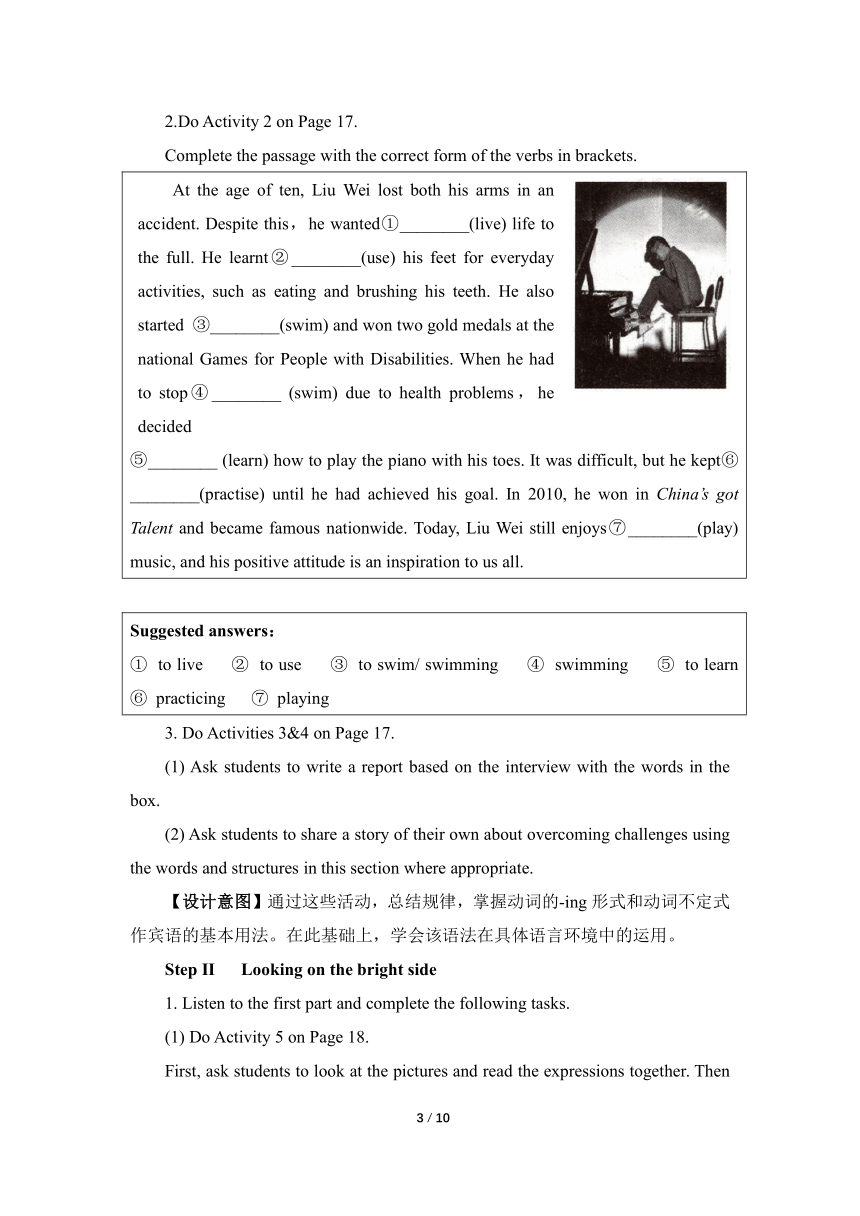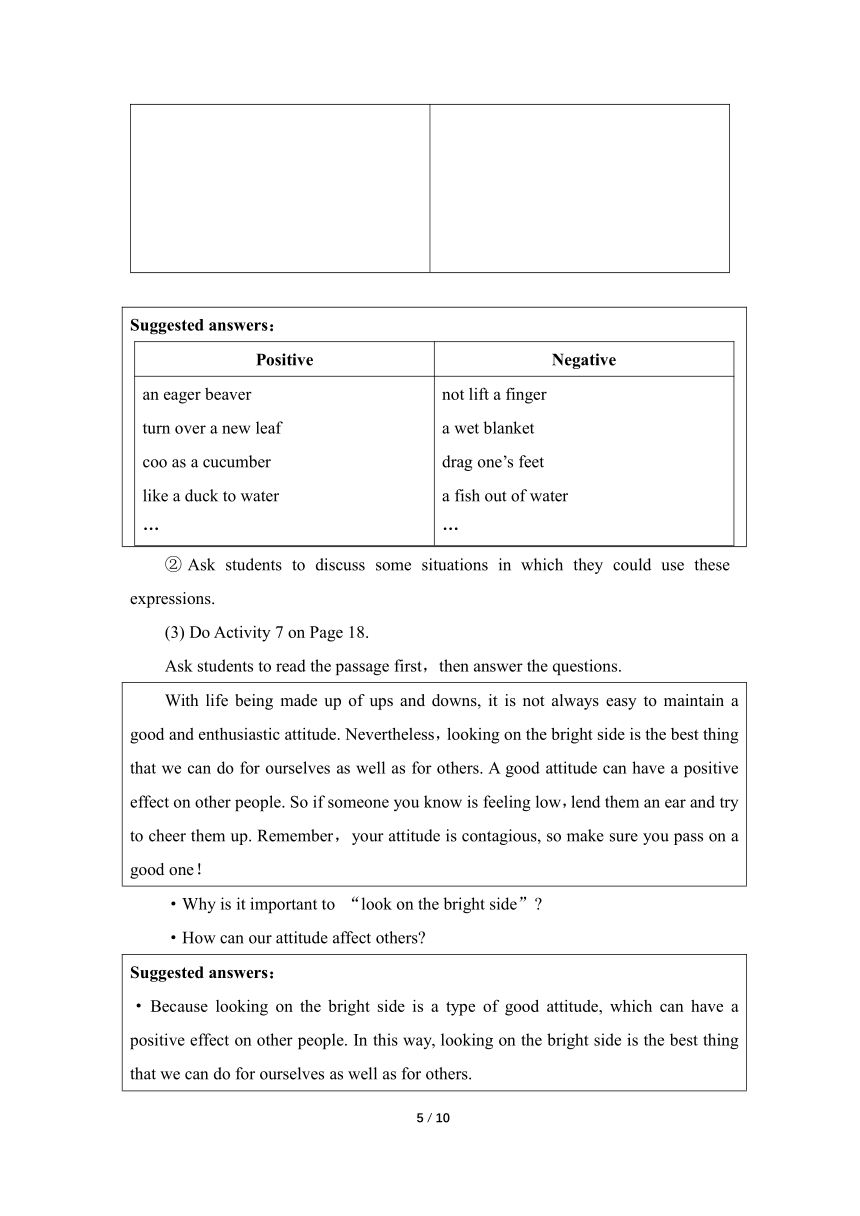外研版(2019)选择性必修第一册Unit 2 Onwards and upwards Using Language 名师教学设计
文档属性
| 名称 | 外研版(2019)选择性必修第一册Unit 2 Onwards and upwards Using Language 名师教学设计 |  | |
| 格式 | docx | ||
| 文件大小 | 9.4MB | ||
| 资源类型 | 教案 | ||
| 版本资源 | 外研版(2019) | ||
| 科目 | 英语 | ||
| 更新时间 | 2023-03-02 11:47:58 | ||
图片预览





文档简介
Unit 2 Using Language 名师教学设计
课时内容
本课时涉及的是语言知识运用,包括-ing and to-infinitive as object和 Looking on the bright side两部分。
-ing and to-infinitive as object学习动词的-ing形式和动语不定式作宾语的用法,学会分类总结哪些动词可跟-ing形式或不定式作宾语。
Looking on the bright side包括两部分:第一部分通过几段小对话了解与人生态度相关的习语和其适用场合以及这些习语的感彩。第二部分为一名学生鼓励在全国英语演讲比赛中失利的另一名学生走出失败的阴影,重振旗鼓的对话。
课时目标
1.掌握本课时的重点单词 worthwhile、enthusiastic、contest、upset、elect以及短语 come across、due to、show concern for、contribute to等的用法,并能在真实语境中灵活运用。
2.掌握动词的-ing形式和动词不定式作宾语的用法。
3.引导学生关注语用功能,学会表达对他人的关心和安慰,并能够在实际生活中运用所学的相关表达。
4.通过学习习语,引导学生看到事物光明的一面,在生活中始终保持乐观的态度,使自己受益终身。
重点难点:
重点:
1.动词的-ing形式和动词不定式作宾语的用法。
2.学会该部分单词、短语的用法。
难点:
动词的-ing形式和动词不定式作宾语的用法。
教学准备:
教师准备:
1.做好该部分内容的PPT和音频材料。
2.准备好一些习语的图片或视频资料,让学生在语境中理解这些习语的含义。
学生准备:
1.总结概括学过的动词中哪些可以用-ing形式作宾语,哪些可以用不定式作宾语。
2.上网查找教材中所涉及的习语的含义,并积累相关的其他词汇。
3.预习课本P17~19的内容,找出该部分的新词汇,并根据上下文猜测其含义。
教学过程:
Step Ⅰ Grammar
1. Do Activity 1 on Page 17.
(1)Ask students to look at the sentences and answer the following questions:
①Do sentences (a) and(b) have the same meaning
②Do sentences(c) and (d) have the same meaning
③Can“receiving”in sentence(e) be changed into“to receive”
Suggested answers: ①Yes, they do. ②No, they don’t. ③No, it can’t.
(2)Give enough examples of the usages of -ing and to-infinitive as object.
(3)Guide students to sum up the usages of -ing and to-infinitive as object.Then ask students to give examples.
【备注】语法知识点讲解详见第二教案“重点语法精讲”。
2.Do Activity 2 on Page 17.
Complete the passage with the correct form of the verbs in brackets.
At the age of ten, Liu Wei lost both his arms in an accident. Despite this,he wanted①________(live) life to the full. He learnt②________(use) his feet for everyday activities, such as eating and brushing his teeth. He also started ③________(swim) and won two gold medals at the national Games for People with Disabilities. When he had to stop④________ (swim) due to health problems,he decided
⑤________ (learn) how to play the piano with his toes. It was difficult, but he kept⑥________(practise) until he had achieved his goal. In 2010, he won in China’s got Talent and became famous nationwide. Today, Liu Wei still enjoys⑦________(play) music, and his positive attitude is an inspiration to us all.
Suggested answers: ① to live ② to use ③ to swim/ swimming ④ swimming ⑤ to learn ⑥ practicing ⑦ playing
3. Do Activities 3&4 on Page 17.
(1) Ask students to write a report based on the interview with the words in the box.
(2) Ask students to share a story of their own about overcoming challenges using the words and structures in this section where appropriate.
【设计意图】通过这些活动,总结规律,掌握动词的-ing形式和动词不定式作宾语的基本用法。在此基础上,学会该语法在具体语言环境中的运用。
Step Ⅱ Looking on the bright side
1. Listen to the first part and complete the following tasks.
(1) Do Activity 5 on Page 18.
First, ask students to look at the pictures and read the expressions together. Then ask them to listen to the conversations and match the expressions to their meanings.
①_________to change your life by starting to be a better person or stopping a bad habit
②_________someone who is extremely enthusiastic and enjoys working extremely hard
③_________to not make any effort
④_________very calm and relaxed, especially in a difficult situation
⑤_________to do something very slowly because you do not really want to do it
⑥_________someone who refuses to Join in,or wants to stop other people having fun
Suggested answers: ① e ② c ③ a ④ f ⑤ d ⑥ b
(2) Do Activity 6 on Page 18.
① Put the expressions in Activity 5 into the boxes.Add any more you can think of.
Positive Negative
Suggested answers: PositiveNegativean eager beaver turn over a new leaf coo as a cucumber like a duck to water …not lift a finger a wet blanket drag one’s feet a fish out of water …
②Ask students to discuss some situations in which they could use these expressions.
(3) Do Activity 7 on Page 18.
Ask students to read the passage first,then answer the questions.
With life being made up of ups and downs, it is not always easy to maintain a good and enthusiastic attitude. Nevertheless,looking on the bright side is the best thing that we can do for ourselves as well as for others. A good attitude can have a positive effect on other people. So if someone you know is feeling low,lend them an ear and try to cheer them up. Remember,your attitude is contagious, so make sure you pass on a good one!
·Why is it important to “look on the bright side”
·How can our attitude affect others
Suggested answers: ·Because looking on the bright side is a type of good attitude, which can have a positive effect on other people. In this way, looking on the bright side is the best thing that we can do for ourselves as well as for others. ·Our attitude is likely to spread to and affect others. If we have a good attitude, others will also feel it and be cheered up by it.
【设计意图】通过以上几个活动,引导学生认识到积极心态的重要性以及对人们的影响,鼓励学生多关注事物的闪光面,树立积极、乐观的人生态度,受益终身。
2.Listen to the second part and complete the following tasks.
(1) Do Activity 8 on Page 19.
Listen to the conversation and number the pictures according to the sequence of events.
Suggested answers: 2 1 4 3
(2) Do activity 9 on Page 19.
Listen again and complete the journal entry.
Suggested answers: ①national English speaking ②he was lucky ③the national competition ④well- known ⑤fantastic people ⑥proud of him
(3) Do Activity 10 on Page 19.
Complete the boxes with the expressions from the conversation.
·Are you OK ·I don’t mean to be nosy, but are you sure ·Why don’t you tell me what’s up ·I’m sure you did your best . ·You should be proud of yourself. ·Why are you so upset ·I know this is hard for you, but you should cheer up.
Showing concern Comforting people
Suggested answers: Showing concernComforting people·Are you OK ·I don’t mean to be nosy, but are you sure ·Why don’t you tell me what’s up ·Why are you so upset ·I’m sure you did your best. ·You should be proud of yourself. ·I know this is hard for you,but you should cheer up.
(4)Do Activity 1l on Page 19.
Divide students into small groups.Each group chooses one situation and acts out a conversation to show concern for people and comfort them.
【设计意图】听力练习设置了两个相应的练习题,第一次听录音,将图片排序;第二次听录音,难度有所增加,要求边听边填写日记缺少的内容。听完录音后,在语言输入的基础上进行语言输出,让学生自已创设语境作对话,提高学生的批判性思维能力。
Step Ⅲ Exercises
Fill in the blanks with the right forms of the words given in the brackets.
①We’re considering__________(pay) a visit to the Science Museum. ②They only allow__________(smoke) in restricted areas. ③I have been used to__________(live) here and love he city. ④I’m fond of__________(collect) stamps and coins. ⑤Remember__________(post) the book for me on your way home. ⑥I remember__________(hand) in my exercise last week. ⑦I’m proud of__________ (win) the first prize in the English competition. ⑧This is how they learn to make friends and to avoid__________(do) things that hurt others.
Suggested answers: ① paying ② smoking ③ living ④ collecting ⑤ to post ⑥ handing ⑦ winning ⑧ doing
【设计意图】通过设置练习题,锻炼学生分析语境的能力,并有意识地总结、归纳哪些动词或短语后面用不定式或-ing形式作宾语。
Step IV Summing up
总结动词的-ing形式和动词不定式作宾语的用法,并注意该部分新学词汇的运用。
Step V Homework
1. Give students some examples to fill in the blanks with -ing and to-infinitive as object.
2. Master the usages of the new vocabulary.
板书设计:
Unit 2 Onwards and upwards Period II Using language I Grammar 1. Do Activity 1 on Page 17. 2. Do activity 2 on Page 17. 3. Do Activities 3&4 on Page 17. Ⅱ. Looking on the bright side 1. Listen to the first part and complete the following tasks. (1) Do Activity 5 on Page 18. (2) Do Activity 6 on Page 18 (3) Do Activity 7 on Page 18. 2. Listen to the second part and complete the following tasks. (1) Do Activity 8 on Page 19. (2) Do Activity 9 on Page 19. (3) Do Activity 10 on Page 19. (4) Do Activity 1l on Page 19. Ⅲ. Exercises IV. Summing up V. Homework
1 / 10
课时内容
本课时涉及的是语言知识运用,包括-ing and to-infinitive as object和 Looking on the bright side两部分。
-ing and to-infinitive as object学习动词的-ing形式和动语不定式作宾语的用法,学会分类总结哪些动词可跟-ing形式或不定式作宾语。
Looking on the bright side包括两部分:第一部分通过几段小对话了解与人生态度相关的习语和其适用场合以及这些习语的感彩。第二部分为一名学生鼓励在全国英语演讲比赛中失利的另一名学生走出失败的阴影,重振旗鼓的对话。
课时目标
1.掌握本课时的重点单词 worthwhile、enthusiastic、contest、upset、elect以及短语 come across、due to、show concern for、contribute to等的用法,并能在真实语境中灵活运用。
2.掌握动词的-ing形式和动词不定式作宾语的用法。
3.引导学生关注语用功能,学会表达对他人的关心和安慰,并能够在实际生活中运用所学的相关表达。
4.通过学习习语,引导学生看到事物光明的一面,在生活中始终保持乐观的态度,使自己受益终身。
重点难点:
重点:
1.动词的-ing形式和动词不定式作宾语的用法。
2.学会该部分单词、短语的用法。
难点:
动词的-ing形式和动词不定式作宾语的用法。
教学准备:
教师准备:
1.做好该部分内容的PPT和音频材料。
2.准备好一些习语的图片或视频资料,让学生在语境中理解这些习语的含义。
学生准备:
1.总结概括学过的动词中哪些可以用-ing形式作宾语,哪些可以用不定式作宾语。
2.上网查找教材中所涉及的习语的含义,并积累相关的其他词汇。
3.预习课本P17~19的内容,找出该部分的新词汇,并根据上下文猜测其含义。
教学过程:
Step Ⅰ Grammar
1. Do Activity 1 on Page 17.
(1)Ask students to look at the sentences and answer the following questions:
①Do sentences (a) and(b) have the same meaning
②Do sentences(c) and (d) have the same meaning
③Can“receiving”in sentence(e) be changed into“to receive”
Suggested answers: ①Yes, they do. ②No, they don’t. ③No, it can’t.
(2)Give enough examples of the usages of -ing and to-infinitive as object.
(3)Guide students to sum up the usages of -ing and to-infinitive as object.Then ask students to give examples.
【备注】语法知识点讲解详见第二教案“重点语法精讲”。
2.Do Activity 2 on Page 17.
Complete the passage with the correct form of the verbs in brackets.
At the age of ten, Liu Wei lost both his arms in an accident. Despite this,he wanted①________(live) life to the full. He learnt②________(use) his feet for everyday activities, such as eating and brushing his teeth. He also started ③________(swim) and won two gold medals at the national Games for People with Disabilities. When he had to stop④________ (swim) due to health problems,he decided
⑤________ (learn) how to play the piano with his toes. It was difficult, but he kept⑥________(practise) until he had achieved his goal. In 2010, he won in China’s got Talent and became famous nationwide. Today, Liu Wei still enjoys⑦________(play) music, and his positive attitude is an inspiration to us all.
Suggested answers: ① to live ② to use ③ to swim/ swimming ④ swimming ⑤ to learn ⑥ practicing ⑦ playing
3. Do Activities 3&4 on Page 17.
(1) Ask students to write a report based on the interview with the words in the box.
(2) Ask students to share a story of their own about overcoming challenges using the words and structures in this section where appropriate.
【设计意图】通过这些活动,总结规律,掌握动词的-ing形式和动词不定式作宾语的基本用法。在此基础上,学会该语法在具体语言环境中的运用。
Step Ⅱ Looking on the bright side
1. Listen to the first part and complete the following tasks.
(1) Do Activity 5 on Page 18.
First, ask students to look at the pictures and read the expressions together. Then ask them to listen to the conversations and match the expressions to their meanings.
①_________to change your life by starting to be a better person or stopping a bad habit
②_________someone who is extremely enthusiastic and enjoys working extremely hard
③_________to not make any effort
④_________very calm and relaxed, especially in a difficult situation
⑤_________to do something very slowly because you do not really want to do it
⑥_________someone who refuses to Join in,or wants to stop other people having fun
Suggested answers: ① e ② c ③ a ④ f ⑤ d ⑥ b
(2) Do Activity 6 on Page 18.
① Put the expressions in Activity 5 into the boxes.Add any more you can think of.
Positive Negative
Suggested answers: PositiveNegativean eager beaver turn over a new leaf coo as a cucumber like a duck to water …not lift a finger a wet blanket drag one’s feet a fish out of water …
②Ask students to discuss some situations in which they could use these expressions.
(3) Do Activity 7 on Page 18.
Ask students to read the passage first,then answer the questions.
With life being made up of ups and downs, it is not always easy to maintain a good and enthusiastic attitude. Nevertheless,looking on the bright side is the best thing that we can do for ourselves as well as for others. A good attitude can have a positive effect on other people. So if someone you know is feeling low,lend them an ear and try to cheer them up. Remember,your attitude is contagious, so make sure you pass on a good one!
·Why is it important to “look on the bright side”
·How can our attitude affect others
Suggested answers: ·Because looking on the bright side is a type of good attitude, which can have a positive effect on other people. In this way, looking on the bright side is the best thing that we can do for ourselves as well as for others. ·Our attitude is likely to spread to and affect others. If we have a good attitude, others will also feel it and be cheered up by it.
【设计意图】通过以上几个活动,引导学生认识到积极心态的重要性以及对人们的影响,鼓励学生多关注事物的闪光面,树立积极、乐观的人生态度,受益终身。
2.Listen to the second part and complete the following tasks.
(1) Do Activity 8 on Page 19.
Listen to the conversation and number the pictures according to the sequence of events.
Suggested answers: 2 1 4 3
(2) Do activity 9 on Page 19.
Listen again and complete the journal entry.
Suggested answers: ①national English speaking ②he was lucky ③the national competition ④well- known ⑤fantastic people ⑥proud of him
(3) Do Activity 10 on Page 19.
Complete the boxes with the expressions from the conversation.
·Are you OK ·I don’t mean to be nosy, but are you sure ·Why don’t you tell me what’s up ·I’m sure you did your best . ·You should be proud of yourself. ·Why are you so upset ·I know this is hard for you, but you should cheer up.
Showing concern Comforting people
Suggested answers: Showing concernComforting people·Are you OK ·I don’t mean to be nosy, but are you sure ·Why don’t you tell me what’s up ·Why are you so upset ·I’m sure you did your best. ·You should be proud of yourself. ·I know this is hard for you,but you should cheer up.
(4)Do Activity 1l on Page 19.
Divide students into small groups.Each group chooses one situation and acts out a conversation to show concern for people and comfort them.
【设计意图】听力练习设置了两个相应的练习题,第一次听录音,将图片排序;第二次听录音,难度有所增加,要求边听边填写日记缺少的内容。听完录音后,在语言输入的基础上进行语言输出,让学生自已创设语境作对话,提高学生的批判性思维能力。
Step Ⅲ Exercises
Fill in the blanks with the right forms of the words given in the brackets.
①We’re considering__________(pay) a visit to the Science Museum. ②They only allow__________(smoke) in restricted areas. ③I have been used to__________(live) here and love he city. ④I’m fond of__________(collect) stamps and coins. ⑤Remember__________(post) the book for me on your way home. ⑥I remember__________(hand) in my exercise last week. ⑦I’m proud of__________ (win) the first prize in the English competition. ⑧This is how they learn to make friends and to avoid__________(do) things that hurt others.
Suggested answers: ① paying ② smoking ③ living ④ collecting ⑤ to post ⑥ handing ⑦ winning ⑧ doing
【设计意图】通过设置练习题,锻炼学生分析语境的能力,并有意识地总结、归纳哪些动词或短语后面用不定式或-ing形式作宾语。
Step IV Summing up
总结动词的-ing形式和动词不定式作宾语的用法,并注意该部分新学词汇的运用。
Step V Homework
1. Give students some examples to fill in the blanks with -ing and to-infinitive as object.
2. Master the usages of the new vocabulary.
板书设计:
Unit 2 Onwards and upwards Period II Using language I Grammar 1. Do Activity 1 on Page 17. 2. Do activity 2 on Page 17. 3. Do Activities 3&4 on Page 17. Ⅱ. Looking on the bright side 1. Listen to the first part and complete the following tasks. (1) Do Activity 5 on Page 18. (2) Do Activity 6 on Page 18 (3) Do Activity 7 on Page 18. 2. Listen to the second part and complete the following tasks. (1) Do Activity 8 on Page 19. (2) Do Activity 9 on Page 19. (3) Do Activity 10 on Page 19. (4) Do Activity 1l on Page 19. Ⅲ. Exercises IV. Summing up V. Homework
1 / 10
